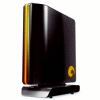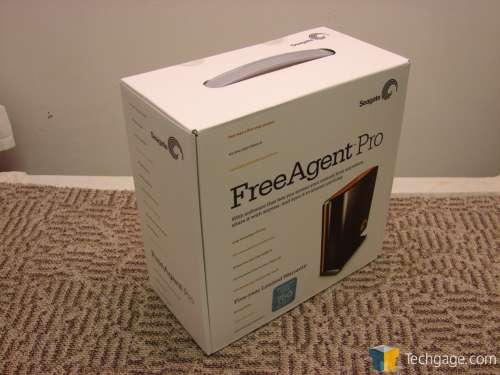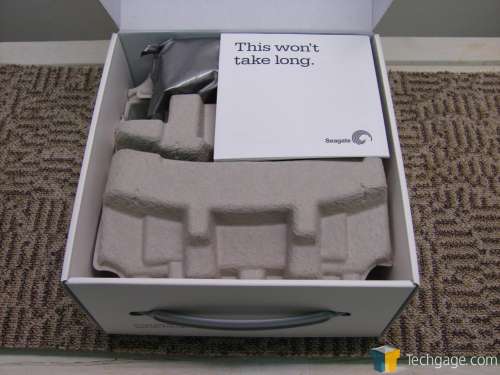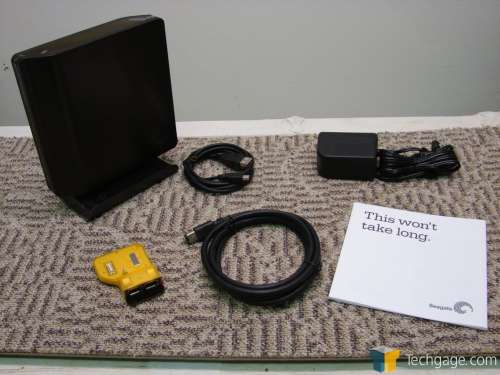- Qualcomm Launches Snapdragon 4 Gen 2 Mobile Platform
- AMD Launches Ryzen PRO 7000 Series Mobile & Desktop Platform
- Intel Launches Sleek Single-Slot Arc Pro A60 Workstation Graphics Card
- NVIDIA Announces Latest Ada Lovelace Additions: GeForce RTX 4060 Ti & RTX 4060
- Maxon Redshift With AMD Radeon GPU Rendering Support Now Available
Seagate FreeAgent Pro 750GB

The Seagate FreeAgent Pro combines a sleek external design with a solid, reliable drive inside. But the FreeAgent’s feature set doesn’t end there. Here’s a look at what makes the Seagate FreeAgent Pro such an attractive solution for anyone looking to add external storage to their system.
Page 2 – What’s In the Box; Specifications
The FreeAgent pro comes in a sturdy, compact retail carton with a carrying handle on the top. The box’s design is minimalist, with a product photo against a white background. The box is peppered with sayings which might be characteristic of a professional who uses the FreeAgent Pro, and many of them have to do with the film production industry ("It’s not long; it’s epic," and "Fire the location scout," for example.)
The front of the FreeAgent’s carton also calls out the drive’s five-year limited warranty, a testament to Seagate’s confidence in their drives. In all the years I’ve been a PC enthusiast, there has always been a brand of hard drives that had a particularly poor reputation for reliability. Back in the late 1990s, it was Western Digital. Then it was IBM’s Deskstar 70GXP series, and more recently that unenviable spot has been filled by Maxtor (before Seagate’s acquisition of Maxtor). And through it all, Seagate has held the top spot on reliability and features, but also price.
The FreeAgent drive itself is packed in a pressed-cellulose clamshell, while the included accessories are each wrapped in the familiar silver anti-static bag, each bag sealed with a yellow sticker that says "hello". The included setup guide assures you that setup will be a simple matter. The tongue-in-cheek sense of humor reflected by the packaging particularly appeals to me; it looks like Seagate’s marketing department is working from a much more modern, less-uptight definition of ‘Professional’.
Included in the retail package is the FreeAgent Pro drive itself, a 120V wall-wart (fancy technical term for those AC adaptors that hang off the outlet), a USB-to-Mini-USB cable, a FireWire cable, and another input module with a pair of FireWire 400 ports. The AC adaptor uses a 90-degree design that won’t block the outlet directly below it.
Seagate’s web site for the FreeAgent product line is conspicuously absent of any ‘specification’ tables per se. However, I did a bit of digging through Seagate’s site and the product’s packaging, and managed to put together this list. I hope Seagate will take the hint soon and add a specifications page to their web site.
|
Spec
|
Comments
|
|
| Model | FreeAgent Pro | Seagate refers to the FreeAgent Pro as a “Data Moverâ€. While its compact form factor lends itself well to portability, its package of software tools add even more options for moving data easily. |
| Capacity | 750GB | As of this writing, this is the largest drive Seagate makes, with Perpendicular Recording Technology. Also available are 320GB and 500GB versions. Word is, Seagate’s readying their 1TB drive, though. |
| Spindle Speed | 7200RPM | 7200rpm isn’t the fastest drive, but when most desktop drives were 5400rpm, a 7200rpm drive provided a significant speed boost. This mechanical parameter of the hard drive has the greatest effect on total data transfer rate, but in the case of an external drive, it’s still limited by the type of connection interface you use. |
| Internal Drive Size | 3.5" | When it comes to providing both high speed and high capacity in a hard drive as economically as possible, 3.5†drives are the only game in town. |
| External Dimensions (H x W x D) |
7.5" x 3.0" x 6.3" | The width of the shell that houses the drive itself is only 1.4†thick, but the base is 3†wide to provide stable footing. |
| Connection Interfaces | USB 2.0 (x1) eSATA (x1) FireWire 400* (x2) |
This drive will work with any machine with a USB port, but USB 2.0 ports will provide a significant speed boost. Of course, this is not news. What is news, however, is the inclusion of blazing-fast eSATA connectivity on all FreeAgent Pro drives. *Some models within the FreeAgent Pro series include a dual Firewire 400 input module. |
Next, we’ll look at the setup process for the FreeAgent drive, as well as its notable features.
|
|
Support our efforts! With ad revenue at an all-time low for written websites, we're relying more than ever on reader support to help us continue putting so much effort into this type of content. You can support us by becoming a Patron, or by using our Amazon shopping affiliate links listed through our articles. Thanks for your support!








